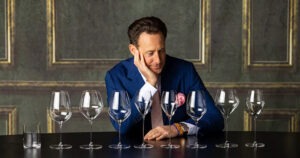
Maximillian Riedel surveys his company’s Veloce wine glass collection.
Why don’t all athletes have the same footwear? After all, you can golf in a tennis shoe, and you can sprint in a dress shoe, right?
The reason, of course, is that your performance will suffer significantly when the product is not specifically designed for its purpose.
It’s the same thing with wine glasses. Try drinking chardonnay out of a Champagne flute or cabernet sauvignon out of a juice glass and you’ll get an idea of the difference it can make. The first thing you’ll notice is how much the aromas are masked. And for those who doubt the importance of smelling while tasting, remember how your taste buds always seem off—or nonexistent—when you have a cold (and if you have any doubt, try tasting something while holding your nostrils closed).
In June, I was invited to attend a seminar in Toronto from Maximilian Riedel, the 11th generation family CEO/president of the heritage Riedel brand. This is arguably the most famous manufacturer of wine glasses in the world, so this was a big deal for wine geeks like me. In his first visit to Canada in ages, Maximilian was at One King West Hotel to showcase his company’s new Veloce collection. Founded in Salzburg, Austria, in 1756, the family-owned Riedel (by the way—it’s pronounced “reedle,” like “needle”) was the first company in history to recognize that the taste and aroma of a beverage is affected by the shape of the vessel from which it is consumed.
In fact, they were probably the first to rethink the traditional shape of wine glasses. Up until the 1950s, the previous 3,000 years of wine glass-making saw all designs flaring out—not tapering—at the top. Inspired by glass design around 1920 by Viennese architects Loos, Hoffmann and Ertl, Claus J. Riedel began taking their work to the next level in the late 1950s. An award-winning example occurred at Expo ’67, when Claus was sent to Montreal to represent Austria. He returned home with the gold medal for design. The company not-so-modestly (but perhaps truthfully) refers to that design as “the mother of all modern wine glasses.”
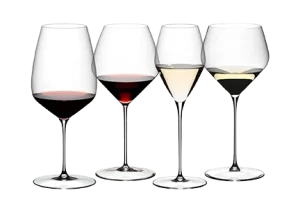
Riedel’s Veloce is the thinnest and lightest line of wine glasses ever made by machine. From left to right is the Cabernet, Pinot Noir, Sauvignon Blanc/Sparkling and Chardonnay glass.
It’s not quite AI yet, but Riedel now has the wine glass design down to a fine science, employing proprietary machine-made technology for a substantial number of its collections. And there’s no shortage of international recognition for their wine glass/varietal-pairing research. They still produce a hand-made series, but the company is extremely proud of the work they’re doing in the machine-made realm. (With no one lining up to blow glass and work in a factory anymore, there isn’t going to be much of a future in handmade glassware anyway, they admit.) The Veloce, which translates to “speed,” is the flagship of that technology. It’s the thinnest and lightest series of wine glasses ever produced by machine. And yet the wide base gives it great stability. “A specially developed machine at Riedel’s Weiden, Germany factory enables us to draw stems that are the equal of those made by hand by a master glassmaker,” Riedel says. “The base, with a diameter of 100 mm, is a new standard for large glass shapes and is the maximum that can be produced by machine.”
Further, the Veloce is dishwasher-safe, contends Riedel (although they do supply a list of dishwasher loading recommendations on their website).
SIZE (AND SHAPE) MATTERS
I’ve actually spoken to groups about the merits of matching your glass to a particular wine varietal, so Max was preaching to the choir here. “Everything a wine has to offer needs to be communicated properly,” he stresses. The aroma, taste, texture, finish and enjoyment of wine is maximized by using the correct ‘wine instrument.’ Conversely, every wine can all be negatively affected by experiencing it in the wrong type of glass.
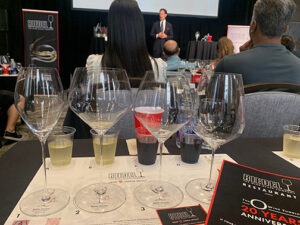
Four wines are lined up with their proper glasses. It’s amazing how different each wine tasted when sipped from alternative glasses.
Grape varietal-specific stemware features mega-researched glass bowl designs consisting of three variables: shape, size and rim diameter. Each plays a part in helping us get the most out of the four sensations in wine:
- Bouquet: Grape varietal-specific stemware is responsible for delivering the quality and intensity of the wine’s aroma.
- Texture: They highlight the diverse styles of ‘mouthfeel’ in wine (watery, creamy, silky, velvety).
- Initial taste: They create a balanced interaction between the fruit, minerality, acidity and bitter components of a wine.
- Flavour: They offer a pleasant, seamless, harmonious and long-lasting aftertaste.
What difference could it possibly make, you wonder? Here’s a really simple example. If you pour a high-alcohol red into a pinot noir or chardonnay fish bowl style of a glass, you can’t help but bury your nose into that glass as you taste it—and the primary smell you’ll consequently encounter will be the burn of the alcohol—not the fruit and complementary aromas the winemaker worked so hard to convey (and that you paid so much to enjoy).
Riedel’s Toronto presentation reminded us of the difference between right and wrong. “There is no one glass that can play the game of wine, and anyone who tells you that has no clue,” Maximillian says. And so, lined up in front of us were wines from four different grapes—all falling under the Caymus umbrella of California: Emmolo Sauvignon Blanc, Mer Soleil Chardonnay, Belle Glos Pinot Noir and Caymus Napa Cabernet Sauvignon. Each was accompanied by its proper glass: an elegant, thin design for the sauvignon blanc; a wider handful of a bowl for the chardonnay; the wide but more tapered bowl for thin-skinned reds like Pinot Noir, Gamay and Nebbiolo; and, finally, the more elongated, slightly tapering model for thicker-skinned reds like cabernet sauvignon, cabernet franc and merlot.
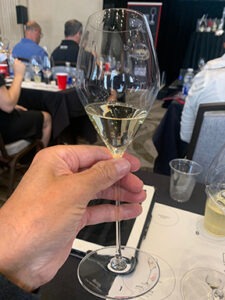
The design of each Veloce glass is so elegant. It blew me away how thin the stems were.
SENSORY DEPRIVATION
Even though I knew what characteristics these wines should exhibit, those attributes were masked, tainted or completely hidden in glasses ill-suited for that particular grape.
We poured the Sauvignon Blanc into its proper glass match. The citrus fruit was apparent—complex, concentrated. The design of Glass 1 requires you to tilt your head way back before the wine flows. That backward tilt makes our tongues unconsciously move forward, meaning the glass delivers the wine to the tip of the tongue before flowing around it. That helped balance the acidity and led to a harmonious finish.
But what if we poured that same wine into the much wider-topped Chardonnay glass next to it? That zesty sauvignon blanc was suddenly harsh, dry and less fruit-driven. Glass two dried our palates, motivating us to drink water—“That’s bad for business,” Maximillian joked. What’s worse, with our heads not moving back much, instead of that bracing acidity being orchestrated by the tip of the tongue, it enveloped the whole tongue. The mouthfeel was completely different. Most of us couldn’t even guess what wine we were drinking, had we not known.
Additionally, while I could smell the sauvignon blanc with one drop in Glass 1, I smelled nothing but glass in Glass 2. That wide top simply couldn’t capture the sauvignon blanc’s molecules. “We know that wine enjoyment goes 70% through our nose,” Maximillian notes. “If we don’t smell, what are we missing?”
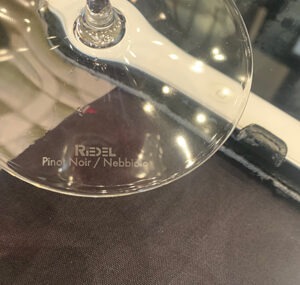
It’s pretty easy to determine if you have the right glass for your wine, since it’s imprinted right on the base.
The same experiences was repeated throughout the lineup. In the proper glass, we were getting the full value and experience of the wine. In the wrong glass? We’d never buy that wine again—or we might send it back if we were at a restaurant.
When we moved to the Mers Soleil 2022 chardonnay, it was three-dimensional in the chardonnay glass, but we noticed only the fruit in glass 1—I never would have guessed California chardonnay. The mouthfeel was also totally different. In glass 3, its aromas were stripped down, with more spice and minerality but precious little fruit or complexity.
The pinot noir, meanwhile, was floral and complex and danced on the tongue in its proper glass. In the Chardonnay glass it was stringent and bitter—a glass clearly not designed to deal with tannins.
The Cabernet Sauvignon, for its part, featured deep, dark and brooding fruit with some mint in its proper glass. But in glass 1 it smelled mostly like sweet coffee. Again, I would have had no clue what wine if this were a blind tasting.
WHAT DOES IT COST?
The bad news is that you get what you pay for. Expect to pay around $50 apiece (although I’ve seen them for as low as $57 for a set of two chardonnay glasses at Walmart).
The good news, however, is that you don’t have to bother remembering what the proper glass is supposed to look like, since the Veloce models all have the varietal literally spelled out on the base of the glass.
Incidentally, the Riedel Sauvignon Blanc glass is also ideal for champagne. “I was the first in my industry to say, 20 years ago, that the Champagne flute is nonsense,” Maximillian observes. “The disadvantage of the flute is that every Champagne in it smells similar—toast and bread—which is the yeast in wine, not the fruit. Champagne belongs in a wine glass. The only reason why the flute was successful for such a long time is marketing and logistics—a little bit of wine fills the glass. Good for business!”
Keep in mind that it doesn’t have to be the new Veloce model you choose. All of Riedel’s glasses are designed to optimize your wine drinking experience. You can visit Riedel’s Wine Glass Guide to identify the right glass for your wine.
Happy sipping!
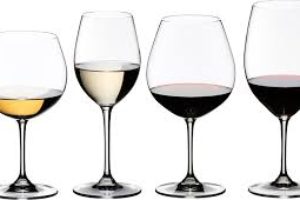

Leave a Reply
Your email is safe with us.